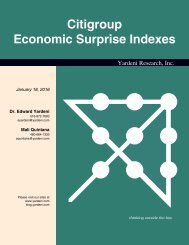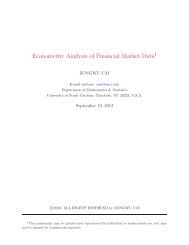Illiquid Asset Investing 1. Liquidating Harvard
Illiquid Asset Investing 1. Liquidating Harvard
Illiquid Asset Investing 1. Liquidating Harvard
Create successful ePaper yourself
Turn your PDF publications into a flip-book with our unique Google optimized e-Paper software.
Andrew Ang <strong>Illiquid</strong> <strong>Asset</strong> <strong>Investing</strong> <strong>Asset</strong> Management<br />
Equities<br />
A large literature finds that many illiquidity variables predict returns in equity markets, with less<br />
liquid stocks having higher returns. 26 These variables include bid-ask spreads, volume, volume<br />
signed by whether trades are buyer or seller initiated, turnover, the ratio of absolute returns to<br />
dollar volume (commonly called the “Amihud measure” based on his paper of 2002), the price<br />
impact of large trades, informed trading measures (which gauge adverse, informed trading, see<br />
below), quote size and depth, the frequency of trades, how often there are “zero” returns (in more<br />
liquid markets returns will bounce up and down), and return autocorrelations (which are a<br />
measure of stale prices). 27 These are all illiquidity characteristics, which are properties unique to<br />
an individual stock. There are also illiquidity risk betas. These are covariances of stock returns<br />
with illiquidity measures, like market illiquidity or signed volume.<br />
Estimates of illiquidity risk premiums in the literature range between 1-8% depending on which<br />
measure of illiquidity is used. However, Ben-Rephael, Kadan and Wohl (2008) report that these<br />
equity illiquidity premiums have diminished considerably – for some illiquidity measures the<br />
risk premiums are now zero! In pinksheet stock markets, which are OTC equity markets, Ang,<br />
Shtauber and Tetlock (2011) find an illiquidity risk premium of almost 20% compared to<br />
comparable listed equity illiquidity risk premiums of approximately 1%.<br />
<strong>Illiquid</strong> <strong>Asset</strong>s<br />
There are higher returns to hedge funds that are more illiquid, in the sense that they place more<br />
restrictions on the withdrawal of capital (called lockups, see Chapter XX) or for hedge funds<br />
26 See the summary article by Amihud, Mendelson and Pedersen (2005).<br />
27 Some of these illiquidity measures produce spreads in expected returns opposite to an illiquidity risk premium,<br />
Stocks with higher than average (normalized) volume, for example, tend to have lower future returns as shown by<br />
Gervais, Kaniel and Mingelgrin (2001).<br />
24




